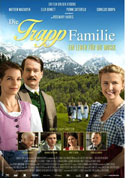

Opening 12 Nov 2015
Directed by:
Ben Verbong
Writing credits:
Paul Günczler, Christoph Silber, Tim Sullivan
Principal actors:
Matthew MacFadyen, Eliza Bennett, Rosemary Harris, Yvonne Catterfeld, Cosima Shaw
This is the fourth film to appear about the life of the Austrian von Trapp family. Earlier films came out in 1956 and 1958 and then the Oscar-winning hit The Sound of Music in 1959. While these were based on a book written by step-mother Maria, this film is based on the book by Agathe von Trapp, written in 2003 when she was 90 years old: Agathe von Trapp: Memories Before and After the Sound of Music.
It’s 1922 in the Austrian countryside near Salzburg. Baron Georg von Trapp and his wife and seven children live in a huge mansion surrounded by acres of land. His wife lies dying of scarlet fever (and not because of having given birth to seven children in almost as many years, which was my first impression). The oldest daughter Agathe (one brother is older) helps wherever she can. When her mother dies, she swears never to sing again. They move into another huge villa, this time in Salzburg. Ten years later Agathe is now a teenager and used to being the head of the household, responsible only to her father. Georg marries the much younger Maria, the children’s nanny, and they have two more children. The arrival of a stepmother causes conflicts, and Agathe gets relief from her loneliness by hanging out with Sigi, the grandson of their former housekeeper. Sigi has moved to Salzburg as an apprentice in a print shop. They meet a famous opera singer, Lotte Lehmann, who convinces Agathe to sing again. Parallel to the family development, the Nazis are gaining power in Germany and will soon spill over into Austria. Father Georg (portrayed as a wimp in this version) refuses to confront the truth; he is still mourning for the old Danube Monarchy of pre WWI-Austria, and his heroic role as submarine captain in WWI. This weak indecision causes Agathe (now 24 years old) and Maria to forget their differences and make plans. The family fortune was lost in 1934, household help given notice. Sigi secretly prints anti-Hitler posters in his print shop and is attacked and killed. With the encouragement of opera singer Lehmann, the family sings at the Salzburg Festspiele. German invades Austria in 1938 and the von Trapps flee to the United States. Here the film ends.
Filmed in Austria and southern Germany, the landscape is beautiful, of course. There are more dirndls than you’ll ever see again, unless you check out The Sound of Music (which is a good idea, if you haven’t seen it already). Someone always has a tear running down a check for different reasons, and it’s often too cutesy, but director Ben Verbong said that he was reproducing the 1940’s film techniques of William Wyler. This is not a musical, but there is music, of course: Christmas songs, Schubert, the Ave Maria, classical folk music. The film’s most valuable contribution is the curiosity it sows to know more of the real facts, all possible in this day of the internet. I wonder when the Kelly family, a popular 1980’s version of the von Trapps, although in Germany, will make a film. (Becky Tan)